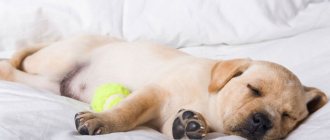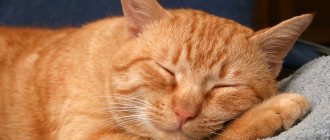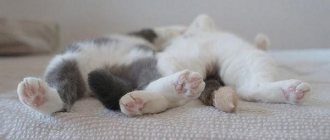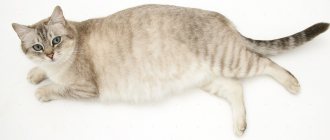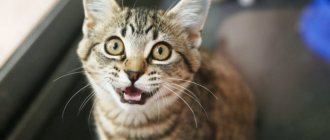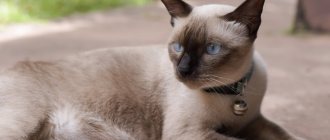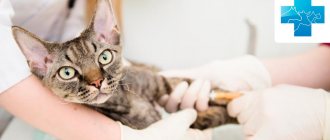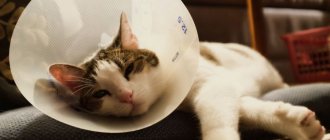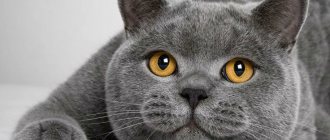Save the article:
No matter how hard a person tries to sleep longer, worries, affairs and responsibilities always interfere with him. But there is little that can distract cats from their dreams: on average, 16 hours a day they cause the envy of their owners, namely, they sleep serenely. If you calculate how much cats sleep during their lives, it turns out that they give 70% to sleep, and spend the remaining 30% on getting more tired and going to sleep.
Playing, tracking down prey, mastering new heights on the street or in the apartment - everything uses up a lot of cat energy, which can only be replenished by long and deep sleep.
Sleep standards for domestic cats
Each cat’s sleep norm is different: not only does it depend on the individual characteristics of the animal, but also on the energy expended during the day. One day the animal may be very tired from a long walk on the street, and on another day it may lie for half a day looking out the window - therefore, the duration of sleepy hours on these days will be different.
The total time allotted for dreaming can vary from 14 to 22 hours. What does total time mean: the pussy does not sleep “from bell to bell”, but easily alternates periods of sleep and activity. The cat gets the missing time in the arms of the owner and in any cozy corner. Cats sleep lightly, so they are easily interrupted by any loud sound, and, as if nothing had happened, they remain awake for some time, in order to soon fall asleep again.
Sleep norms for newborn kittens are different - they constantly doze next to their mother, waking up only to feed. Gradually, their waking hours increase, but they sleep somewhat less than adults. Older cats relapse into childhood and dream again constantly, waking up to litter and feed.
How long do adult cats sleep?
global $ads_google;
//data-ad-slot=”2475549904″ $ads_google = empty($ads_google) ? false : true; ?> if ($ads_google == false) {?> $ads_google = true; ?> } ?> If you compare how much an adult cat and a tiny newborn kitten sleeps per day , the kids will win. But then the emphasis shifts - the older ones sleep for a long time, and the kittens spend a lot of time playing.
For a healthy, tired cat, it will not be a deviation from the norm if he sleeps 20 hours in one day: his body may require such a long hibernation.
If an adult animal, which is one of the record holders for sleep among mammals, suddenly sleeps little, it means that it is in a state of stress. If this problem continues, the cat may lose a lot of weight and become ill due to nervousness.
In general, a cat needs to sleep 12-14 hours a day, but the total amount of hours spent on this is sometimes difficult to determine precisely because of the frequent alternation of periods of dreaming and activity.
How long do kittens sleep?
A healthy kitten at a tender age will easily sleep 22 hours in one day. This is not a reason to worry, but a variant of the norm. Age plays a significant role: if newly born kittens immediately fall asleep after eating, then cats at the age of one or two months play for a long time next to their mother, study the world around them and are in no hurry to fall asleep. A mother cat often spends much more time sleeping than her curious children.
If an older kitten sleeps a lot, and in addition to this, he has poor appetite and low activity, then this is a reason to consult a veterinarian with suspected illness.
Your cat's sound sleep: is there a norm?
Contents hide
Domestic purrs are considered dormouse - a fact beyond any doubt. It seems they are ready to sleep for days on end and even more. However, the owners are not very upset. Everyone has heard the phrase that cats are the personification of home comfort. Let's make one important clarification: namely sleeping (or, at worst, washing) cats. A pet snoring sweetly means that life in the house is going on as usual. So everything is fair.
However, readers often ask questions: is there a certain sleep norm for cats? How long should these wonderful animals sleep? It is difficult to give an unambiguous answer to these questions - so and so. It all depends on the temperament and character of the cat itself, its lifestyle, age, health status and other individual characteristics.
According to experts from the American Society for the Prevention of Cruelty to Animals (ASPCA), the average healthy adult cat should sleep about 16 hours a day. That is, approximately twice as much as the average person sleeps - or rather, he is recommended to sleep. But 16 hours is a rather arbitrary figure. So, some cats can sleep for 13 hours, feeling “vigorous”, others, after long amorous adventures, sleep for 18 or even 20 hours. But one should not assume that cats are useless and idle creatures. Very useful, judging by the number of mustachioed pets in our houses and apartments. It’s just that any waking session for a cat is a big event, during which it expends a colossal amount of energy. Don’t smile skeptically, friends: purrs give a lot of energy, even when they hang around their owners, begging for an unscheduled portion of food. Walking to an already filled bowl is like a hard cross-country race for track and field athletes. And if the tailed one has been chasing her favorite toy bird or fish to her heart’s content, then it’s time to fall completely exhausted and not get up. We are being a little ironic, but we convey the general essence correctly: cats invest a huge amount of energy in every movement, in every jump, in every play session. Let's look at cats (including big and wild ones) living in nature, at the same lions, leopards and cheetahs. Cheetahs are recognized sprinters. They put all their strength into a short pursuit of the victim, developing crazy speed. Throw is luck. All about everything in about ten to fifteen minutes. Having had enough, you can indulge in a sweet nap.
Let's also not forget that cats primarily maintain a nocturnal, or rather, twilight lifestyle. They go hunting as soon as the heat of the day subsides and the sun disappears behind the horizon. Natural instincts are also alive in domestic cats. So the advice to “tire restless pets” before bed has a practical basis. The cat runs around, lets off steam, and then sleeps peacefully, without causing any inconvenience to anyone.
Cats sleep almost their entire lives. Scientists have calculated more or less accurately: purrs spend two-thirds of their lives in the arms of Morpheus, significantly surpassing other mammals. With age, as they get older, people with mustaches sleep more than they did in their prime. The phenomenon is unique: older people, for example, sleep an order of magnitude less than in their youth.
Some cautions and tips. You know your pet much better than us. He can sleep continuously throughout his “norm”, as well as he can sleep in “sessions”: periods of sleep followed by short periods of activity. Everything here is individual. But it is advisable to note and record any sudden changes in ingrained habits. If a once active cat suddenly begins to sleep for days, curled up in a ball, be wary. Better yet, take the mustache to the vet. Stress and a general depressed state are possible. The doctor will examine the animal and give his verdict. Unfortunately, a disease has been identified - it must be treated. The point is negative feelings and emotions - special medications that reduce anxiety levels will help.
Material used : What Is a Normal Amount of Time a Cat Sleeps? Author: Naomi Millburn . Source: pets.thenest.com Photo: pexels.com
How long do cats sleep after anesthesia?
The behavior of pets and their condition after surgery always worries worried owners.
If a cat is about to be sterilized, then naturally the owner will be concerned about how much she will sleep after the operation. The body cannot ignore anesthesia, so after it and surgery it will take time to recover. Some creatures recover from anesthesia very quickly and wake up immediately, while others take longer.
If we are talking about a cat, then the question of how long he will sleep after castration also has an answer: it all depends on the individual characteristics of the pet’s body. In any case, he will need the care and attention of his owner. The veterinarian will definitely give important recommendations on this matter.
Sleep phases of cats
People who have cats in the house can constantly observe how a seemingly soundly sleeping pet suddenly jumps up and rushes at maximum speed to the kitchen, to the owner or to the door. For cats that have become well-adapted to resting during light naps, waking up abruptly is normal. These animals constantly pick up information from everywhere, so there is nothing strange in such a rapid succession of states.
Cat dreams are divided into two phases, which replace each other:
- slow phase: decreased blood pressure, low muscle activity, decreased heart rate, slow breathing. The eyes under closed eyelids, at the moment of falling asleep, slowly move a little and then stop
- fast phase: rapid heartbeat, change in breathing rate, rapid rotation of the eyes, slightly increased blood pressure and body temperature, possible shudders, movement of the limbs and ears.
The fast phase in adult cats takes up to 25% of the total time, in old cats 15%. The slow phase lasts 20-30 minutes, and then it is replaced by a fast phase for 5-7 minutes. Over a long period of sleep, the phases alternate several times.
Sleep Features
Cats spend almost two-thirds of the day sleeping, but any deviation in the direction of a significant decrease or increase in hours of sleep should force the owner to take a closer look at the pet. Little kittens can generally sleep almost all the time, interrupting only for food and a short exploration of the world around them. Adults become more active, mobile and spend periods of wakefulness longer and more interesting.
Several factors can influence sleep duration:
- seasonality and weather conditions, in hot weather cats become sleepier,
- age, small kittens and older individuals sleep more,
- how full the pet is, the feeling of satiety always makes you sleepy,
- the atmosphere of the house, the calmer and more comfortable, the more serene the pet rests,
- activity and health.
It is worth noting that overfed cats can sleep more than normal and be less active and mobile than their “slender” counterparts.
© shutterstock
Cats cannot sleep continuously. He goes through phases, the first of which is dozing. At this time, processes slow down, but the cat can return from dormancy to wakefulness instantly. If nothing interferes, he falls into a deep sleep. And then complete relaxation sets in, during which it is quite difficult to wake up the pet.
These two phases constantly alternate. At the same time, you still need to leave time for games, entertainment and, of course, delicious food.
Do cats dream?
global $ads_google;
//data-ad-slot=”2475549904″ $ads_google = empty($ads_google) ? false : true; ?> if ($ads_google == false) {?> $ads_google = true; ?> } ?> How much time cats sleep per day has been determined, now it’s interesting to find out whether four-legged friends have dreams. Neuroscientists studied this issue and came to the conclusion that domestic cats are no strangers to dreams. This is usually something that has to do with the cat's lifestyle. This could be a battle with a wild relative, an active pursuit of prey, exploration of a new territory, or something associated with strong emotions.
How and when do cats sleep?
If a cat does not sleep at the required hours, being in a relaxed state, but looks for a secret place for dreams, it means that she is not so comfortable next to her owner. Normally, a cat would rather prefer the master's bed than the corner under the sofa. An animal that completely trusts its owner easily falls asleep on his lap, turning over on its back and putting all four paws in front of it.
When a cat is 9 years old, she slept for about 6 years of that time.
The place to sleep will most often be located at some elevation, and it will be something soft and warm. The cat will stomp on the chosen bed, stretch, relaxing every muscle, and very quickly falls asleep.
There are also originals among cats, which seem to be smeared with honey on the owner’s laptop, important documents on the table or freshly ironed linen.
Cats sleeping problems
In cases where a cat, not exceeding its usual sleep norm, suddenly begins to constantly doze off and look drowsy, it is first determined whether this is due to pregnancy or weather conditions (excessive heat or extreme cold). If a cat spends more than 18 hours sleeping, then such drowsiness may come from some kind of disease. A cat's sleeping position can help identify the problem: a frozen posture like a sphinx or attempts to spread its limbs that are unusual for an animal indicate hyperthermia. Also, an excessive amount of sleep is an indicator of the onset of heart problems.
Other sleep disorders include insomnia. Stress caused by moving, the arrival of a new family member, or an influx of guests may be to blame here. Sometimes cats have seizures in their sleep - it’s better to film any oddities and then show it and the animal to a veterinarian.
Causes of prolonged sleep due to pathologies
Dangerous reasons include the following:
- Stress. The trigger can be anything: a move, a new addition to the family (including the appearance of a new pet), a change of owner, new food. The cat is lethargic, eats little or, conversely, its appetite increases. Obsessive licking to bald spots and antisocial behavior are observed.
- Poisoning. Trembling, heavy breathing, vomiting, diarrhea, loss of appetite, abnormal temperature, unhealthy mucous color are characteristic signs of poisoning. The animal could be poisoned by food, human food, indoor or outdoor plants, medicines, household chemicals, poisons, etc.
- Low or high blood pressure. In the first case, the animal becomes drowsy, nauseated, appetite decreases, the pulse slows down, and sometimes loss of consciousness occurs. Signs of high blood pressure: apathy, dilated pupils, red eyes, blurred vision, vomiting, rapid heartbeat, swelling of the paws, nosebleeds, noises when breathing.
- Diseases of the endocrine system (hormonal imbalance, diabetes, Cushing's syndrome). Signs of endocrine disorders: thirst, instability of appetite, frequent urination, weight fluctuations, deterioration of the skin and coat, local obesity in the abdominal area, cramps, heavy gait, physical inactivity due to muscle weakness, vision problems.
- Diseases of the musculoskeletal system. Characteristic signs: changes in gait, cautious movements, avoidance of jumping, lameness, pain, swelling, loss of appetite, reluctance to groom oneself (does not sharpen claws, does not lick itself).
- Cancer. Diarrhea, vomiting, including with signs of internal bleeding, plaintive meowing, rapid weight loss, bad breath, swelling, ulcers - all this indicates oncology.
- Infections. Loss of appetite, shortness of breath, cough, high fever, diarrhea, vomiting, wheezing when breathing, watery eyes and nose, discoloration of the mucous membranes are signs of infectious diseases.
- Parasites (fleas, ticks, worms and other living creatures). Signs of worms: weight loss, gastrointestinal upset, gas formation, bad breath, bloated stomach, greenish discharge from the eyes. Signs of ear mites: itching, head shaking, ear scratching, excessive wax production, brown coating in the ears. Signs of fleas: skin irritation, wounds, bald patches, peeling skin.
- Inflammation of internal organs. Any internal inflammation makes the cat lethargic and apathetic. Other manifestations depend on the specifics of the pathology and the affected organ.
- Avitaminosis. In addition to lethargy, there is a deterioration in the condition of the skin and coat. Hypovitaminosis occurs with a monotonous, poor diet or malnutrition.
- Anemia. There is shortness of breath, blue mucous membranes, deterioration of the coat, low blood pressure, and arrhythmia.
- Dehydration. Dry mucous membranes, sunken eyes, dry nose, cold pads on the paws, viscous and sticky saliva are all signs of dehydration. At the same time, the animal eats and drinks less.
- Foreign object. Vomiting, refusal to eat and drink, excessive salivation, and hoarseness indicate that the animal has a bone, plastic, or something else stuck in its throat.
- Consequences of surgery (hernia, suture dehiscence, sepsis). If, 3 days after the operation, the cat refuses food and water, meows pitifully, hardly moves, and has an elevated temperature and signs of dyspepsia, then this indicates complications.
If the owner has recently spayed or castrated a cat, then apathy and long sleep are considered normal for 1-3 days. However, it is important to monitor your pet's condition. He must drink, the temperature must be normal, and there must be no suppuration.
